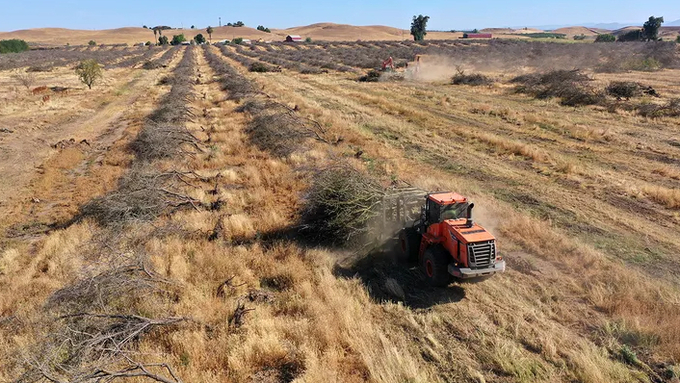November 28, 2025 | 04:20 GMT +7
November 28, 2025 | 04:20 GMT +7
Hotline: 0913.378.918
November 28, 2025 | 04:20 GMT +7
Hotline: 0913.378.918

In an aerial view, a worker with Fowler Brothers Farming uses a wheel loader to move a pile of almond trees during an orchard removal project May 27, 2021, in Snelling, Calif. Photo: Justin Sullivan/Getty Images / Getty Images
Extreme weather, which poses a significant risk to the agriculture sector, could push already elevated food prices even higher, according to a Wells Fargo economist.
Farmers and ranchers have experienced extraordinary cost pressures in recent years due to extreme weather conditions.
However, that pressure is now being exacerbated by Russia's war in Ukraine as well as coronavirus-related supply chain disruptions, Wells Fargo economist Charlie Dougherty told FOX Business.
For one, severe drought in the West and Midwest has reduced agriculture production and already led to higher prices for consumers, Dougherty said.
Food prices have repeatedly outpaced the overall consumer price index except for June and March. The elevated prices are straining most consumers, especially lower-income families who are being forced to rely on food banks.
Food prices in August increased 11.4% compared with a year ago, according to data from the Labor Department and compared to a rise of 8.3% for all items.
Grocery prices have continued to rise rapidly, soaring 13.5%, which marked the biggest annual increase since 1979.

A bale of hay in a field during a heat wave outside Elgin, Texas, July 20, 2022. Photo: Sergio Flores/Bloomberg via Getty Images / Getty Images
Chicken prices, in particular, have skyrocketed, jumping nearly 17% in the past year, according to unadjusted government data. Meanwhile, meat prices have risen 6.7% from a year ago.
Unfortunately, many factors are out of farmers' control. For instance, prolonged heat, less precipitation and unseasonably cold temperatures have not only reduced crop yields, but also lowered pasture quality, Dougherty said. On top of that, fire risks have increased as water resources have become strained.
Dougherty couldn't predict how long these extreme weather conditions could impact food prices but noted that extreme weather "could lead to downstream food prices being persistently higher in the future."
Meanwhile, the conflict between Russia and Ukraine drove sharp increases in fertilizer and diesel fuel costs.
Russia and Belarus fertilizer shipments account for more than 20% of global fertilizer exports, according to Wells Fargo's "The State of Agriculture" report last month.
The region is also a significant global source of wheat and soybeans. The conflict reduced both of these supplies, which "sent prices higher earlier this year, although prices have come back down in recent months," Dougherty said.
Farm equipment has been hard to find due to the fact that manufacturers are battling "shortages of key material inputs, while food processors have been hit hard by labor shortages," according to Dougherty.
(Fox Business)

(VAN) A new study reveals how the simultaneous effects of ocean acidification, salinity and loss of oxygen are making the world more fragile.

(VAN) Hopes are growing that the creation of the first 3D turkey gut model could be a turning point in the battle against the virulent blackhead disease.

(VAN) Tyson, America’s biggest meat supplier, plans to shutter one of its largest beef processing plants as the industry continues to struggle with low cattle supplies and political pressure from Washington.

(VAN) New FAO study shows how digital solutions are empowering farmers and fishers to prevent losses and build resilient agrifood systems.

(VAN) Brazil's COP30 presidency pushed through a compromise climate deal on Saturday that would boost finance for poor nations coping with global warming but that omitted any mention of the fossil fuels driving it.

(VAN) Poultry farmers in the UK have been warned that they could face one of the worst winters yet for bird flu.

(VAN) Prices of main-crop paddy have risen sharply, with jasmine rice hitting 16,100 baht per tonne — the highest level in years.